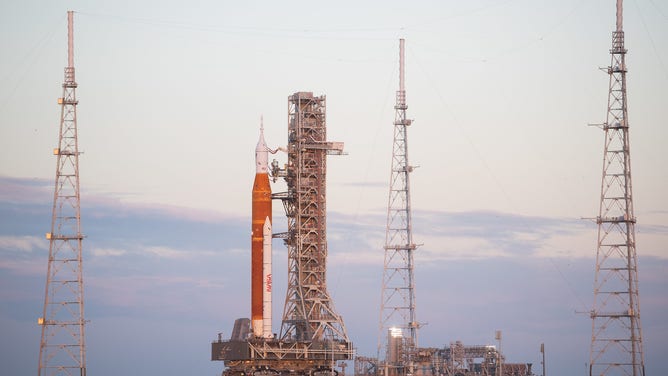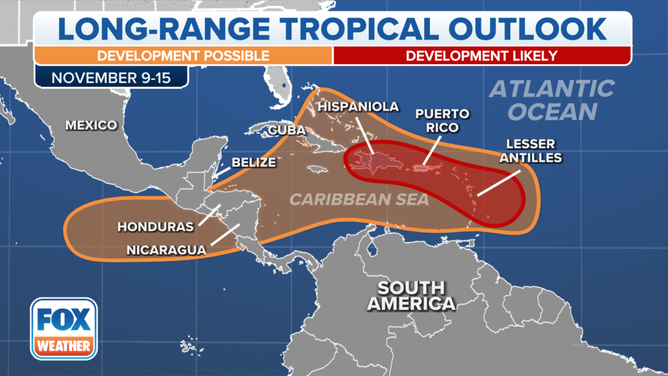NASA's moon rocket arrives at Kennedy Space Center launchpad ahead of 3rd launch attempt
NASA is targeting Nov. 14 at 12:07 a.m. EST to launch the Artemis 1 test flight from Kennedy Space Center launchpad 39B, sending the Orion spacecraft on a monthlong orbit around the moon.

NASA’s Space Launch System (SLS) rocket with the Orion spacecraft aboard is seen atop the mobile launcher as it arrives at Launch Pad 39B, Friday, Nov. 4, 2022, at NASA’s Kennedy Space Center in Florida. Photo Credit: (NASA/Joel Kowsky)
(NASA)
KENNEDY SPACE CENTER, Fla. – NASA teams moved the Space Launch System rocket and Orion spacecraft to the launchpad for another try at conducting the Artemis 1 test flight around the moon.
NASA management is hopeful this is the final outing to the launchpad for the agency's mega moon rocket, which has made the 4-mile journey to the pad for two other launch attempts this year. Using the crawler transporter, the rocket moved at 2 mph and took about 10 hours to reach its destination.
The space agency is targeting Nov. 14 at 12:07 a.m. EST to launch the Artemis 1 test flight from Kennedy Space Center launchpad 39B, sending the Orion spacecraft on a monthlong orbit around the moon and back. This uncrewed test flight is a critical precursor to SLS launching astronauts on the Artemis 2 mission and then the first human moon landing for the program by 2025.
WHAT IS NASA'S ARTEMIS 1 MISSION GOING TO DO?
NASA managers told reporters this week they are confident about this latest launch decision.
While inside the Vehicle Assembly Building, teams worked over the past month to swap out Flight Termination System batteries, recharge some science payload batteries and perform other maintenance on the SLS and Orion.
"Right now, we are very confident in our team and our systems, and we're looking forward to getting back out to the pad and getting launched on the 14th," said Jim Free, associate administrator for NASA Exploration Systems Development Mission Directorate.
The crawler made the first motion to move the SLS to the pad at 12:01 a.m. Friday and completed the trek about 8:30 a.m.
Two previous attempts – one in late August and the other in September – ended in launch scrubs due to technical issues with fueling the rocket with super-cold liquid hydrogen, which commonly leaks.
After the most recent launch attempt in September and a fueling test to work on a hydrogen leak, NASA decided to roll back the 322-foot-tall rocket to the VAB as Hurricane Ian was barreling toward Florida's west coast.
"When we had to roll back from the hurricane, I will tell you, it was disappointing," said Cliff Lanham, KSC Ground System senior vehicle operations manager. "But what I will say is the team immediately got to work, literally, when we were allowed on center after the hurricane. The enthusiasm and the efficiency of the team has been tremendous, outstanding."
Lanham confirmed there was no damage from Hurricane Ian to any of the facilities used by the Artemis vehicle. The Category 4 hurricane made landfall on Sept. 28 near Fort Myers with 150-mph winds and a deadly storm surge.
ARTEMIS-1 MOON ROCKET FUELING TEST COMPLETE AFTER NASA ENGINEERS OVERCOME HYDROGEN LEAK
With the latest launch window in darkness, the views will be less than ideal than the previous daytime launch attempts, but Free said the launch team is confident in the overnight launch plan.
If Artemis 1 does not launch on Nov 14, there are backup opportunities on Nov. 16 at 1:04 a.m. and Nov. 19 at 1:45 a.m.
Forecasters watching tropical development for launch

The long range tropical outlook ahead of the Artemis 1 launch.
(FOX Weather / FOX Weather)
The Florida weather cooperated for the rocket's overnight journey to the launchpad.
Looking ahead to next week when launch preparations get underway, Launch Weather Officer Mark Burger said the Space Force 45th Weather Squadron would be watching the tropics closely as the Atlantic hurricane season nears its end.
One area of potential development south of Puerto Rico is forecast to move northwest over the next week. The National Hurricane Center is giving the system a low chance of development as of Thursday. Even if the system does not become a tropical storm or hurricane, it's forecast to send a low-pressure system toward Florida with wind and rain.
WHEN IS THE TYPICAL LAST HURRICANE STRIKE ON THE U.S. COAST?
"Regardless of whether or not it's named, pretty much what we're targeting is that through the middle part of next week, especially as we go Monday night into potentially Tuesday night or early Wednesday, us having the highest impact from that particular system as it approaches the Florida peninsula," Burger said.
More than a week away, Burger said those impacts could be sustained winds of nearly 30 mph with some rain squalls, but still within the SLS launch weather constraints.
The FOX Forecast Center continues to track several systems currently in the tropics. The official end of the Atlantic hurricane season is Nov. 30.